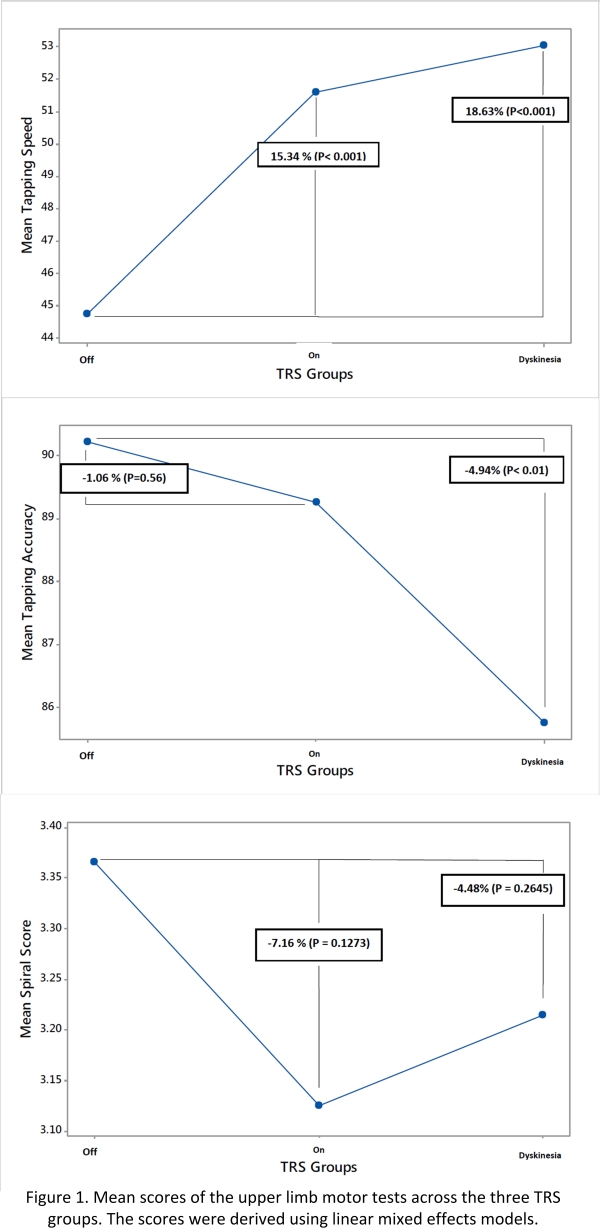Session Information
Date: Thursday, June 23, 2016
Session Title: Parkinson's disease: Clinical trials, pharmacology and treatment
Session Time: 12:00pm-1:30pm
Location: Exhibit Hall located in Hall B, Level 2
Objective: The aim of this study was to investigate whether upper limb motor tests are related to clinical ratings of motor function in Parkinson’s disease (PD).
Background: Assessments of symptoms and follow-up of treatments in PD patients are mostly done by using clinical rating scales like Unified PD Rating Scale (UPDRS). However, these scales may be prone to low reliability and sensitivity to therapeutic changes.
Methods: Nineteen advanced PD patients were recruited in a single center, open label, single dose clinical trial in Sweden. Patients were video recorded while performing standardized motor tasks and the videos were blindly rated by three independent movement disorder specialists. The ratings were given using the Treatment Response Scale (TRS) on a scale from -3 = ‘Very Off’ to 0 = ‘On’ to 3 = ‘Very dyskinetic’. In addition, patients performed upper limb motor tests (tapping and spiral drawings) using a touch screen device. Tapping tests were performed using first right hand and then left hand. The spiral test was repeated three times per test occasion, using the dominant hand. The measurements were repeated over several time points following a single levodopa/carbidopa morning dose (50% over normal to evoke dyskinesia). Three TRS groups were derived after mean TRS ratings of the three raters were pooled as following: Off (including ratings from -3 to <-1), On (-1 to 1), and Dyskinesia (>1 to 3). For tapping tests, accuracy and speed scores were calculated and mean scores of both hands were used in subsequent analysis. A computer method generated a ‘spiral score’ representing PD-related drawing impairments and mean of the three test trials was used in subsequent analysis.
Results: The mean tapping speed was lower when patients were rated as being Off as compared to when they were rated as being On (p<0.001) and dyskinetic (p<0.001, see Fig 1). In contrast, tapping accuracy was higher when patients were rated as being Off as compared to being dyskinetic (p<0.01). However, there were no differences in tapping accuracy between Off and On motor states. Patients had the best spiral scores when they were rated as being On. 
Conclusions: The results from this study indicate that the upper limb motor tests may be useful in differentiating Off and dyskinesia motor states from On state in advanced PD patients. The tapping speed captured Off symptoms whereas accuracy was related to dyskinesias.
To cite this abstract in AMA style:
M. Memedi, S. Aghanavesi, D. Nyholm, H. Askmark, S.M. Aquilonius, R. Constantinescu, F. Bergquist, A. Medvedev, A. Ericsson, F. Ohlsson, S. Lycke, J. Spira, M. Senek, J. Westin. Upper limb motor tests are related to clinical ratings of motor function in advanced Parkinson’s disease [abstract]. Mov Disord. 2016; 31 (suppl 2). https://www.mdsabstracts.org/abstract/upper-limb-motor-tests-are-related-to-clinical-ratings-of-motor-function-in-advanced-parkinsons-disease/. Accessed December 25, 2025.« Back to 2016 International Congress
MDS Abstracts - https://www.mdsabstracts.org/abstract/upper-limb-motor-tests-are-related-to-clinical-ratings-of-motor-function-in-advanced-parkinsons-disease/
